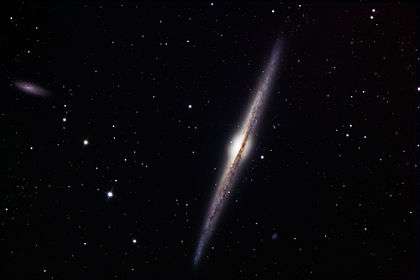NGC 4565
| NGC 4565 | |
|---|---|
|
NGC 4565 or Needle Galaxy | |
| Observation data (J2000 epoch) | |
| Constellation | Coma Berenices |
| Right ascension | 12h 36m 20.8s[1] |
| Declination | +25° 59′ 16″[1] |
| Redshift | 0.004103[1] |
| Helio radial velocity | 1230 ± 5 km/s[1] |
| Distance |
42.7 ± 12 Mly (13.1 ± 3.7 Mpc)[2] 53 ± 4 Mly (16.2 ± 1.3 Mpc)[3] |
| Apparent magnitude (V) | 10.42[1] |
| Characteristics | |
| Type | SA(s)b?[1] |
| Apparent size (V) | 15′.90 × 1′.85[1] |
| Other designations | |
| UGC 7772,[1] PGC 42038,[1] Caldwell 38 | |
NGC 4565 (also known as the Needle Galaxy or Caldwell 38) is an edge-on spiral galaxy about 30 to 50 million light-years away[2] in the constellation Coma Berenices.
This galaxy, appearing of 10th visual magnitude, sits perpendicularly to the Milky Way galaxy, being is almost directly above the North Galactic Pole.
It is known as the Needle Galaxy for its narrow profile.[4] First spotted in 1785 by William Herschel, it is one of the most famous examples of an edge-on spiral galaxy.[5] "Visible through a small telescope, some sky enthusiasts consider NGC 4565 to be a prominent celestial masterpiece Messier missed."[4]
Characteristics
NGC 4565 is a giant spiral galaxy more luminous than the Andromeda Galaxy.[6]
Much speculation exists in the literature as to the nature of the central bulge. In the absence of clear-cut dynamical data on the motions of stars in the bulge, the photometric data alone cannot adjudge among various options put forth. However, its exponential shape suggested that it is a barred spiral galaxy.[7] Studies with the help of the Spitzer Space Telescope not only confirmed the presence of a central bar but also showed a pseudobulge within it as well as an inner ring.[8][8]
NGC 4565 has at least two satellite galaxies, one of which is interacting with it.[9]
It has a population of roughly 240 globular clusters, more than the Milky Way.[6]


References
- 1 2 3 4 5 6 7 8 9 "Results for NGC 4565". NASA/IPAC Extragalactic Database. Retrieved 2006-10-12.
- 1 2 "Distance Results for NGC 4565". NASA/IPAC Extragalactic Database. Retrieved 2010-05-02.
- ↑ Jensen, Joseph B.; Tonry, John L.; Barris, Brian J.; Thompson, Rodger I.; et al. (February 2003). "Measuring Distances and Probing the Unresolved Stellar Populations of Galaxies Using Infrared Surface Brightness Fluctuations". Astrophysical Journal. 583 (2): 712–726. arXiv:astro-ph/0210129
 . Bibcode:2003ApJ...583..712J. doi:10.1086/345430.
. Bibcode:2003ApJ...583..712J. doi:10.1086/345430. - 1 2 NGC4565 at http://apod.nasa.gov/apod/ap040409.html
- ↑ Spiral Galaxy NGC 4565 at http://www.eso.org/gallery/v/ESOPIA/Galaxies/phot-24a-05.tif.html
- 1 2 Globular Cluster Systems in Galaxies Beyond the Local Group
- ↑ "Intermediate-band surface photometry of the edge-on galaxy NGC 4565" at http://www.iop.org/EJ/article/1538-3881/123/3/1364/201272.text.html
- 1 2 Detection of a Distinct Pseudobulge Hidden Inside the ``Box-Shaped Bulge of NGC 4565
- ↑ HALOGAS: H I Observations and Modeling of the Nearby Edge-on Spiral Galaxy NGC 4565
External links
| Wikimedia Commons has media related to NGC 4565. |
- NGC 4565 on WikiSky: DSS2, SDSS, GALEX, IRAS, Hydrogen α, X-Ray, Astrophoto, Sky Map, Articles and images
- National Optical Astronomical Observatory – NGC 4565
- APOD (2010-03-04) – NGC 4565: Galaxy on Edge
- APOD (2009-04-28) – NGC 4565
Coordinates: ![]() 12h 36m 20.8s, +25° 59′ 16″
12h 36m 20.8s, +25° 59′ 16″
